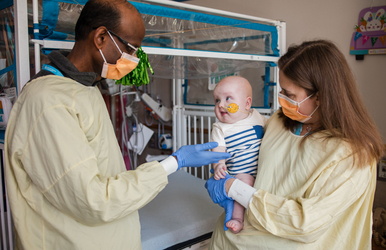The N-of-1 accomplishment provides a template for swift, personalized genetic therapies.
Beth Mole – May 16, 2025

Rebecca Ahrens-Nicklas, MD, PhD, and Penn Medicine’s Kiran Musunuru, MD, PhD, visiting KJ
News broke yesterday that researchers in Philadelphia appear to have successfully treated a 6-month-old baby boy, called KJ, with a personalized CRISPR gene-editing therapy. The treatment corrects an ultra-rare mutation in KJ that breaks a liver enzyme. That enzyme is required to convert ammonia, a byproduct of metabolism, to urea, a waste product released in urine. Without treatment, ammonia would build up to dangerous levels in KJ—and he would have a 50 percent chance of dying in infancy.
While the gene-editing treatment isn't a complete cure, and long-term success is still uncertain, KJ's condition has improved and stabilized. And the treatment's positive results appear to be a first for personalizing gene editing.
Now, who doesn't love a good story about a seemingly miraculous medical treatment saving a cute, chubby-cheeked baby? But, this story delivers more than an adorable bundle of joy; the big triumph is the striking timeline of the treatment's development—and the fact that it provides a template for how to treat other babies with ultra-rare mutations.
Breakneck breakthrough
The gene editing technology used for KJ is not exactly new, nor is the delivery system. CRISPR has already proven to be a successful gene therapy. What's stunning is the speed. KJ's mutation was identified within days of his birth. Within weeks, researchers were growing cells in petri dishes that carried genetic sequences copied from KJ. In month two, they used those cells to train molecular gene-editing machinery to target and correct KJ's mutation—a spot in the DNA coding for the liver enzyme where there's a T (thymine) instead of a C (cytosine). At the beginning of the third month, researchers had created genetically engineered mice that carry KJ's specific mutation, too.In the boy's fourth month, researchers were meeting with the Food and Drug Administration to discuss regulatory approval for a clinical trial—a trial where KJ would be the only participant. They were also working with the institutional review board (IRB) at Children’s Hospital of Philadelphia to go over the clinical protocol, safety, and ethical aspects of the treatment. The researchers described the unprecedented speed of the oversight steps as being "through alternative procedures."
In month five, they started toxicology testing in mice. In the mice, the experimental therapy corrected KJ's mutation, replacing the errant A-T base pair with the correct G-C pair in the animals' cells. The first dose provided a 42 percent whole-liver corrective rate in the animals. At the start of KJ's sixth month, the researchers had results from safety testing in monkeys: Their customized base-editing therapy, delivered as mRNA via a lipid nanoparticle, did not produce any toxic effects in the monkeys.
A clinical-grade batch of the treatment was readied. In month seven, further testing of the treatment found acceptably low-levels of off-target genetic changes. The researchers submitted the FDA paperwork for approval of an "investigational new drug," or IND, for KJ. The FDA approved it in a week. The researchers then started KJ on an immune-suppressing treatment to make sure his immune system wouldn't react to the gene-editing therapy. Then, when KJ was still just 6 months old, he got a first low dose of his custom gene-editing therapy.
“Transformational”
After the treatment, he was able to start eating more protein, which would have otherwise caused his ammonia levels to skyrocket. But he couldn’t be weaned off of the drug treatment used to keep his ammonia levels down (nitrogen scavenging medication). With no safety concerns seen after the first dose, KJ has since gotten two more doses of the gene therapy and is now on reduced nitrogen scavenging medication. With more protein in his diet, he has moved from the 9th percentile in weight to 35th or 40th percentile. He's now about 9 and a half months old, and his doctors are preparing to allow him to go home from the hospital for the first time. Though he will have to be closely monitored and may still at some point need a liver transplant, his family and doctors are celebrating the improvements so far.In the past, the development of such a treatment would have taken years. But the swift and diligent response to KJ's condition led to timely treatment. The timeline and steps provide a guide for development of other customized gene therapies.
KJ's treatment was presented this week at the American Society of Gene & Cell Therapy Annual Meeting in New Orleans. It was also simultaneously published in the New England Journal of Medicine.
In an accompanying editorial, Peter Marks—a former top regulator at the FDA—called KJ's treatment a "platform technology" that could be used as a template for treating millions of others with rare genetic conditions. "The development of gene-editing products to address N-of-1 disorders with the use of mRNA encapsulated in lipid nanoparticles represents one of the most obvious opportunities for the application of a platform-technology approach that could be transformational," he wrote.
In all, KJ's treatment "shows the potential strength of the application of cutting-edge science and technology with a forward-leaning regulatory approach to safely expedite the development and availability of life-saving medicines," Marks wrote.
KJ's doctors agree. “Years and years of progress in gene editing and collaboration between researchers and clinicians made this moment possible, and while KJ is just one patient, we hope he is the first of many to benefit from a methodology that can be scaled to fit an individual patient’s needs," said Rebecca Ahrens-Nicklas, a pediatrician and gene therapy expert at CHOP and the University of Pennsylvania, who treated KJ.